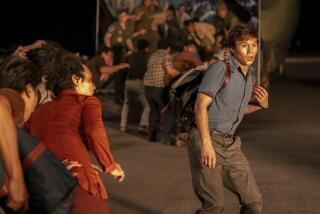Remains of 7 Missing GIs Come Home From Vietnam
HANOI — The remains of seven American servicemen killed in a war that ended a generation ago were placed in flag-draped caskets at Noi Bai International Airport here Tuesday and carried with military honors aboard an Air Force jet bound for home.
Moments later, the giant C-141 Starlifter thundered into the mist-shrouded skies of Hanoi’s winter morning, and Sen. John F. Kerry, himself a combat veteran of the Vietnam War, said quietly to no one in particular: “Thirty years and going home at last.”
Although the victims were publicly unidentified, families had been notified that the remains were presumably those of loved ones. The seven Americans’ names were engraved on the Vietnam Memorial in Washington long ago. When each is positively identified, the cross by his name on the black marble wall will be changed to a star.
Their repatriation lowered to 1,566 the number of Americans still listed as missing in action in Vietnam, according to figures released by U.S. officials this week. Another 533 are missing in Laos and Cambodia. Of the MIAs in Vietnam, U.S. authorities believe that they can account for the fates of all but 42, even though they have not found remains to prove that conviction.
Since the United States began searching for its MIAs in 1994, with the cooperation of the Vietnamese government, the remains of 263 Americans--sometimes nothing more than teeth or bone fragments--have been located and sent to the Army’s Central Identification Laboratory in Hawaii. The shortest time it took to identify remains was four months; the longest, 10 years.
When the first Americans were repatriated, Vietnam would not let U.S. officials cover their caskets with the American flag. That prohibition ended as relations between Washington and Hanoi improved. In Laos, government authorities initially insisted that remains be carried away in ordinary suitcases, the occasion attended by neither ceremony nor publicity.
Six weeks ago, the Laotian government relented, hoping to curry goodwill in its efforts to obtain most-favored-nation trading status from the United States. Caskets were covered with the U.S. flag, and journalists were invited to report on the turnover of several sets of remains to U.S. authorities.
Among the first to arrive at Hanoi’s commercial airport on Tuesday were four civilian members of the Vietnam Veterans of America (VVA), including Tom Corey of West Palm Beach, Fla., who is confined to a wheelchair as a result of being shot in the neck in a firefight in Quang Tri province.
The veterans are traveling through Vietnam to try to help families locate the remains of 300,000 Vietnamese still listed as MIAs from the war against the U.S. The VVA effort, begun in 1994, has provided information on the fates of about 8,000 MIAs.
The American veterans carried maps of mass graves that U.S. troops dug with bulldozers after “policing up” battlefields of corpses, as well as a videotape of the battle for Kham Duc near Da Nang and identification papers and photographs that GIs had taken from corpses as mementos. The materials were turned over to the VVA by veterans in the United States to help with the search.
“We’ve been talking with the Vietnamese from the beginning about building trust, and this builds trust,” Corey said. “As American vets who are committed to families of MIAs, if we didn’t follow through on this and bring the families the information we have, we wouldn’t be fulfilling our duties as vets.”
On the runway, the remains of the seven Americans rested in numbered wooden containers, each hardly bigger than a shoe box. A Vietnamese customs official gently pried loose each top with a screwdriver and inspected the contents, before signing papers that gave Lt. Col. John Kelly, commander of the MIA task force in Vietnam, possession of the “shipment.”
With Kerry, a Massachusetts Democrat, and U.S. Ambassador Douglas “Pete” Peterson--who spent more than six years as a POW in Vietnam--looking on, the 11-person honor guard from Hawaii moved with precision, placing each wooden box in one of the nearby flag-wrapped aluminum caskets. The same type of casket was used 30 years ago this month to carry home U.S. servicemen being killed in Vietnam at the rate of more than 1,000 a week in the Tet offensive.
The huge rear doors of the C-141 Starlifter opened, and one by one the caskets, accompanied by the honor guard and the civilian Vietnam War vets, were placed inside. Under international law, the plane’s interior was sovereign United States territory, and so in a dark cargo hold, the seven missing Americans were home at last.
More to Read
Sign up for Essential California
The most important California stories and recommendations in your inbox every morning.
You may occasionally receive promotional content from the Los Angeles Times.










